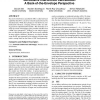Free Online Productivity Tools
i2Speak
i2Symbol
i2OCR
iTex2Img
iWeb2Print
iWeb2Shot
i2Type
iPdf2Split
iPdf2Merge
i2Bopomofo
i2Arabic
i2Style
i2Image
i2PDF
iLatex2Rtf
Sci2ools
HOTNETS
2010
2010
Successive interference cancellation: a back-of-the-envelope perspective
Successive interference cancellation (SIC) is a physical layer capability that allows a receiver to decode packets that arrive simultaneously. While the technique is well known in communications literature, emerging software radios are making practical experimentation feasible. This motivates us to study the extent of throughput gains possible with SIC from a MAC layer perspective. Contrary to our initial expectation, we find that the gains from SIC are not easily available in many realistic situations. Moreover, we observe that the scope for SIC gets squeezed by the advances in bitrate adaptation, casting doubt on the future of SIC based protocols. Categories and Subject Descriptors C.2.1 [Network Architecture and Design]: Wireless Communication General Terms Experimentation, Performance
Computer Networks | HOTNETS 2010 | Physical Layer Capability | SIC Based Protocols | Successive Interference Cancellation |
| Added | 17 May 2011 |
| Updated | 17 May 2011 |
| Type | Journal |
| Year | 2010 |
| Where | HOTNETS |
| Authors | Souvik Sen, Naveen Santhapuri, Romit Roy Choudhury, Srihari Nelakuditi |
Comments (0)

